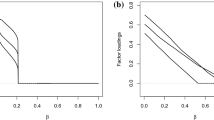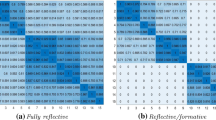Abstract
Extended redundancy analysis (ERA) is a multivariate analysis procedure that regresses dependent variable(s) on the component scores, defined as weighted sums of independent variables. ERA requires information on the group structure of the independent variables, which is not available in many cases. The research proposes a new exploratory variant of ERA called exploratory ERA (ExERA), which does not require the group structure but estimates it using the dataset. ExERA is further classified into the following two procedures: ExERA-Sp and ExERA-R. ExERA-Sp estimates the group structure of independent variables by sparsely estimating the weight matrix, while ExERA-R approximates a similar structure obtained using ExERA-Sp and obliquely rotating the weight matrix. The performance of the two procedures was investigated using numerical simulation and a real data example. The results showed that the proposed methods were effective for exploratory data analysis.
Similar content being viewed by others
Data availability
Data will be made available on reasonable request by readers.
References
Adachi K (2011) Constrained principal component analysis of standardized data for biplots with unit-length variable vectors. Adv Data Anal Classif 5(1):23–36
Adachi K, Trendafilov NT (2018) Sparsest factor analysis for clustering variables: a matrix decomposition approach. Adv Data Anal Classif 12:559–585
Aggarwal CC, Reddy CK (2013) Data clustering: algorithms and applications. CRC Press, Boca Raton
Anderson TW (1951) Estimating linear restrictions on regression coefficients for multivariate normal distributions. In: The Annals of Mathematical Statistics, 327–351
Bentler PM (1980) Multivariate analysis with latent variables: causal modeling. Annu Rev Psychol 31(1):419–456
Bentler PM (1986) Structural modeling and Psychometrika: an historical perspective on growth and achievements. Psychometrika 51(1):35–51
Bernaards CA, Jennrich RI (2003) Orthomax rotation and perfect simple structure. Psychometrika 68(4):585–588
Chen L, Huang JZ (2012) Sparse reduced-rank regression for simultaneous dimension reduction and variable selection. J Am Stat Assoc 107(500):1533–1545
Chu MT, Trendafilov NT (2001) The orthogonally constrained regression revisited. J Comput Graph Stat 10(4):746–771
Fornell C, Barclay DW, Rhee BD (1988) A model and simple iterative algorithm for redundancy analysis. Multivar Behav Res 23(3):349–360
Fu L, Lin P, Vasilakos AV, Wang S (2020) An overview of recent multi-view clustering. Neurocomputing 402:148–161
García-Baquero Moneo G, Gowing DJ, Wallace H (2022) The contribution of the spatial hydrological niche to species diversity in rare plant communities of English floodplain meadows. Plant Ecol 1–14
Gower JC, Dijksterhuis GB (2004) Procrustes problems (Vol. 30). OUP Oxford
Harris CW, Kaiser HF (1964) Oblique factor analytic solutions by orthogonal transformations. Psychometrika 29(4):347–362
Harville DA (1997) Matrix algebra from a Statistician’s perspective. Springer, New York
Hastie T, Tibshirani R, Wainwright M (2015) Statistical Learning with Sparsity, The Lasso and Generalizations. Chapman and Hall/CRC, New York
Hendrickson AE, White PO (1964) Promax: a quick method for rotation to oblique simple structure. Br J Stat Psychol 17(1):65–70
Hirose K, Terada Y (2022) Sparse and simple structure estimation via prenet penalization. Psychometrika
Hwang H, Takane Y (2004) Generalized structured component analysis. Psychometrika 69(1):81–99
Hwang H, Takane Y (2014) Generalized structured component analysis: a component-based approach to structural equation modeling. CRC Press, Boca Raton
Hwang H, DeSarbo WS, Takane Y (2007) Fuzzy clusterwise generalized structured component analysis. Psychometrika 72(2):181
Izenman AJ (2008) Modern multivariate statistical techniques. In: Regression, classification and manifold learning. Springer-Verlag, New York.
Jennrich RI (2002) A simple general method for oblique rotation. Psychometrika 67(1):7–19
Jennrich RI (2006) Rotation to simple loadings using component loss functions: the oblique case. Psychometrika 71:173–191
Johansson JK (1981) An extension of Wollenberg’s redundancy analysis. Psychometrika 46(1):93–103
Kaiser HF (1974) An index of factorial simplicity. Psychometrika 39(1):31–36
Mayekawa S, Yamashita N (2020) Bayesian reduced rank multigroup regression analysis: a new model for multigroup data with hybrid parameter sharing. Behaviormetrika 47(2):411–426
McMahan CD, Fuentes-Montejo CE, Ginger L, Carrasco JC, Chakrabarty P, Matamoros WA (2020) Climate change models predict decreases in the range of a microendemic freshwater fish in Honduras. Sci Rep 10(1):1–10
Mulaik SA (1972) The foundation of factor analysis. McGraw-Hill, New York
Mulaik SA (1986) Factor analysis and Psychometrika: major developments. Psychometrika 51(1):23–33
Mulaik SA (2009) Foundations of factor analysis (second edition). CRC Press, Boca Raton
Rao CR (1964) The use and interpretation of principal component analysis in applied research. Sankhyā Indian J Stat Ser A 329–358
Reinsel GC, Velu RP, Chen K (2022) Multivariate reduced-rank regression: theory, methods and applications, 2nd edn. Springer, New York
Takane Y, Hwang H (2005) An extended redundancy analysis and its applications to two practical examples. Comput Stat Data Anal 49(3):785–808
Tenenhaus M, Vinzi VE, Chatelin YM, Lauro C (2005) PLS path modeling. Comput Stat Data Anal 48(1):159–205
Thorne ED, Ford WM (2022) Redundancy analysis reveals complex den use patterns by eastern spotted skunks, a conditional specialist. Ecosphere 13(1):e3913
van den Wollenberg AL (1977) Redundancy analysis an alternative for canonical correlation analysis. Psychometrika 42(2):207–219
Yamashita N, Adachi K (2020) Permutimin: factor rotation to simple structure with permutation of variables. Multivar Behav Res 55(1):17–29
Yamashita N, Mayekawa S (2014) A new biplot procedure with joint classification of objects and variables by fuzzy c-means clustering. Adv Data Anal Classif 9(3):243–266
Yanai H, Takagi H (1986) Handbook of Multivariate Analysis. Genda-Sugaku-Sha (In Japanese)
Yanai H, Takeuchi K, Takane Y (2011) Projection matrices, generalized inverse matrices, and singular value decomposition. Springer, New York
Yoshikawa K, Kawano S (2022) Sparse reduced-rank regression for simultaneous rank and variable selection via manifold optimization. Comput Stat
Zhao Z, Palomar DP (2018) Sparse reduced rank regression with nonconvex regularization. In: 2018 IEEE Statistical Signal Processing Workshop (SSP). IEEE, pp 811–815
Zou H, Hastie T, Tibshirani R (2006) Sparse principal component analysis. J Comput Graph Stat 15(2):265–286
Funding
This research was supported by JSPS KAKENHI Grant Number 23K16854.
Author information
Authors and Affiliations
Corresponding author
Ethics declarations
Conflict of interest
The author has no relevant financial or non-financial interests to disclose.
Additional information
Communicated by Kei Hirose.
Publisher's Note
Springer Nature remains neutral with regard to jurisdictional claims in published maps and institutional affiliations.
About this article
Cite this article
Yamashita, N. Exploratory extended redundancy analysis using sparse estimation and oblique rotation of parameter matrices. Behaviormetrika 50, 679–697 (2023). https://doi.org/10.1007/s41237-023-00200-7
Received:
Accepted:
Published:
Issue Date:
DOI: https://doi.org/10.1007/s41237-023-00200-7




